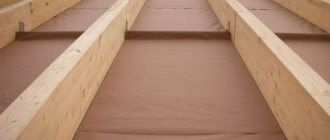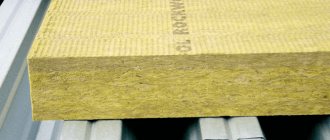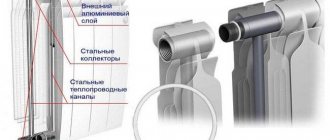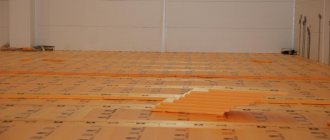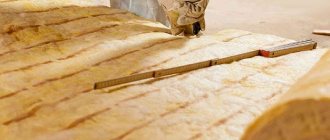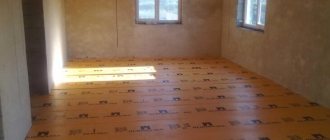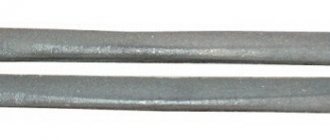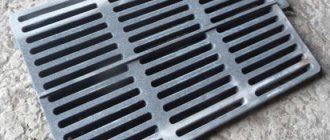Mineral wool is a popular thermal insulator that is often used in the form of slabs during the construction of a house. It is placed in different building structures. To choose the right thermal insulation material, you need to know the existing dimensions of mineral wool insulation in slabs. We’ll tell you when you need to take into account the dimensions of this material and about its existing varieties. Let's also consider GOST brands and sizes, how the optimal thickness is selected and under which well-known brands this insulation is produced.
Packaged mineral wool slabs Source 24aul.ru
General information
Not a single house in Russia is built without the use of thermal insulation material. Insulation is even used during the construction of buildings in warm regions. This is directly related to its properties. After all, it keeps rooms not only warm, but also cool in hot weather. Therefore, even at the initial stage of construction, when material is purchased, it is so important to know the dimensions of the insulation.
In addition, when choosing and purchasing a heat insulator, you must not make a mistake with its manufacturer. After all, you need to use high-quality insulation to create building structures with effective thermal insulation.
In addition, correctly selected mineral wool, the dimensions of which are known, will allow you to properly prepare the base. As a result, it will be possible to quickly lay the material. Therefore, time will be saved and construction time will be reduced. Moreover, in most cases, slab material does not even have to be trimmed if a competent building structure is calculated and prepared for it in advance, for example, in the form of a frame.
Laying mineral wool in a pre-prepared frame made of wooden blocks Source baseel.ru
Usually they try to take into account the dimensions of mineral wool when construction is carried out:
- Floors with insulation due to dense laying of mineral wool between adjacent joists.
- Attics with living rooms, because the size of the mineral wool in the slabs affects the distance between the joists, rafters and the configuration of each cell in the partitions if there are several rooms in the roof.
- Frame houses, because mineral wool is used during the construction of walls and other building structures of such buildings.
During external work, when cladding facades, for example, with siding, a frame is also often first created, which is used to secure not only the finishing material, but also the heat insulator. Therefore, in such a situation, you also need to know the size of the mineral wool insulation for the walls.
Of course, the popularity of this material is associated with its properties. Moreover, such insulation is produced in a convenient form for installation, transportation and storage.
The shape of mineral wool in the form of slabs allows for convenient installation, transportation and even storage of the material Source dachnaya-zhizn.ru
Application area
Basalt wool is used in various sectors of the national economy. It can be found in fine and coarse water purification filters, in the composition of soil for drip irrigation, pipeline transport, etc. However, the main area of application is industrial and residential construction. Here the material is used for insulation:
- flat roofs;
- attic space;
- floor bases;
- interfloor floors and ceilings;
- external and internal walls;
- foundation from inside the building;
- walls with multi-layer masonry;
- frame houses made of sandwich panels.
In addition, such material properties as fire resistance, fire resistance and the ability to absorb airborne noise are used. Therefore, on sale you can find:
- basalt wool for the chimney - protects flammable elements of the building from contact with an overheated chimney;
- soundproofing mats for recording studios;
- rigid slabs for constructing a “wet” facade, on which you can immediately plaster.
Types of mineral wool
For many decades, mineral wool has been in demand in construction. This name refers to fibrous insulation material. This is a generalized name for heat insulators, for the manufacture of which manufacturers use various inorganic raw materials. At the same time, many of them produce mineral wool, the slab dimensions of which are standard.
This type of insulation is used in the construction of approximately 70% of all private houses. Mineral wool is produced in accordance with the technical requirements of GOST 31913-2011.
Differences in mineral wool based on the raw materials used
Mineral wool is produced by weaving fibers that are obtained from various inorganic raw materials. During manufacturing, they are tightly connected to each other. Therefore, the slabs are elastic, but the material has an airy structure. Its type is influenced by the composition of the initial mixture, which is used in the production of the heat insulator.
Stone or basalt wool
To produce this type of mineral wool, different rocks are used. Manufacturers often use basalt.
Basalt wool slabs Source asamrockwool.com
Also used in production:
- dolomite;
- diabase;
- limestone;
- porphyrite
Thermal insulation boards made from only one basalt fiber have almost the same properties as glass wool. This material is used exclusively on technological devices. It is used to isolate equipment at various enterprises.
In building structures, insulating boards are used, which, in addition to stone fibers, also contain additives of mineral and synthetic origin. These are connecting components. Manufacturers change their percentage in the material, producing slabs of different densities. This characteristic must be taken into account when choosing the dimensions of mineral wool insulation. The mechanical properties of the heat insulator also depend on the amount of binders.
Basalt slabs of different thicknesses Source vuuhh.com
See also: Catalog of companies that specialize in home insulation
Glass wool
This type of thermal insulation material is commonly called glass wool. In its production, quartz sand, lime and soda are used. Exactly the same components are used to make ordinary glass. Manufacturing enterprises that extrude this material have to dispose of the scrap. This is what is used in the manufacture of glass wool. Substandard glass products are also introduced into the mixture for the production of insulation.
Glass wool is an excellent insulating material that retains heat well. However, it is used less and less in the form of slabs and other versions, because its fibers have increased fragility. Even with a slight mechanical impact on glass wool, a large number of small particles with very sharp edges are ejected from the material.
Glass wool slabs Source sense-life.com
It is precisely because of small sharp particles that it is inconvenient to work with glass wool. A person has to protect all exposed areas of the body and respiratory organs. To increase the level of safety during installation of glass wool, manufacturers produce the material in a durable shell. This is what helps reduce health risks.
Slag
To produce this type of insulation, waste from blast furnace production is used. Slag wool is sold at a more affordable price than other similar fibrous thermal insulation materials. At the same time, it has less thermal resistance and inferior thermal conductivity.
In addition, slag wool absorbs water well. Therefore, it is not used for insulating foundations, roofing structures and external walls. Slag wool is also characterized by low environmental safety and a short service life. It is not used in the construction of private houses. Therefore, the thickness, length and width of insulation in the form of slag wool are of no interest to either homeowners or builders involved in the construction of low-rise residential buildings.
Slag wool is one of the most harmful varieties of mineral wool Source rusvoin.ru
Differences in mineral wool in shape
Large areas are insulated using mineral wool. This becomes possible due to the fact that the material is light, has good elasticity, and has an excellent ability not to change its dimensions. Although roll insulation is often used in construction, heat insulation in the form of slabs is still more popular.
Wall structures and roofs are insulated with mineral wool. For these purposes, rectangular slabs with a rigid and semi-rigid structure are used. For their installation, it is necessary to prepare a solid foundation in advance.
In addition, mineral wool slabs themselves can withstand a small load. Therefore, they are often used during external thermal insulation of a building under a thin protective plaster layer. The thickness of mineral wool for wall insulation is almost always the same over its entire area.
Roll and slab of mineral wool Source fresh-lifehack.ru
Some characteristics of insulation
Foam is widely used for insulating walls, floors and ceilings. In the attic, the functions of walls and ceiling are performed by the roof of the building. It is not recommended to use polystyrene foam to insulate it for the following reasons:
Stages of attic roof insulation.
- all roof elements, including insulation material, must be well ventilated;
- the insulation must allow air and moisture vapor to pass through well.
According to the laws of physics, warm air rises from bottom to top. Polystyrene foam does not allow moisture contained in warm air to pass through at all. This will lead to the formation of condensation from inside the room. As a result, within 1-3 years the parts of the rafter structure will become damp, trickles of water will begin to flow through the insulation material, mold will appear, and the wooden parts of the roof will begin to rot.
Very common materials are mineral wool and glass wool. They have low cost and excellent resistance to high temperatures. When working with glass wool, it is necessary to take special protective measures, since the smallest particles of glass when they come into contact with open areas of the skin cause severe irritation and significant pain. You can only work in protective clothing, gloves and goggles. The thickness of the thermal insulation layer made of mineral wool or glass wool is selected at the rate of 15-30 cm. This depends on the climatic zone in which the house is located.
Attic roof insulation elements: 1 – mineral wool; 2 – vapor and wind barrier (membrane); 3 – waterproofing; 4 – air flows; 5 – rafter; 6 – roof; 7 – attic cladding.
The negative aspects of this insulating material include its slight deformation and hygroscopicity, which can lead to a decrease in thermal insulation properties. Glass wool is also not an environmentally friendly material. Therefore, it is preferable to use mineral wool. You need to purchase mineral wool based on a density of 40-45 kg per cubic meter. This is optimal. Mineral wool is a material that provides:
- environmental safety;
- non-flammability;
- good sound insulation;
- resistance to moisture and temperature changes;
- frost resistance;
- protection from rodents and other pests;
- resistance to fungus and mold;
- quick and easy installation.
You can use felt, hemp, sawdust, and reed slabs. But all these materials require preliminary antiseptic and fire retardant treatment. These operations significantly increase the life of thermal protection equipment.
Sandwich panels are more expensive than mineral wool, but guarantee the quality and durability of the insulation. They consist of several layers: vapor barrier, insulation, waterproofing, decorative.
Foam glass slabs are a relatively new and expensive insulation material. Has high strength. The material is quite elastic and resistant to various mechanical influences. Ideal for thermal protection when using soft roofing.
Gost dimensions
There are clear requirements for insulating mineral wool. They are formulated in the state standard.
Gostov grades of mineral wool slabs
When choosing insulation, you need to know not only the brand and size of stone wool in the slabs, but also the scope of its application. After all, each type of such material differs in performance indicators.
Fiber insulation is characterized by the degree of deformation when it is compressed. This material also comes in different grades. They allow you to find out its density.
In accordance with GOST, there are the following designations for mineral wool slabs:
- PM is a soft board that can have a density of 40 or 50 kg/m3.
Insulation with the lowest characteristics is used during the construction of floors on the first floor of the house. It is also used in the construction of floors and pitched roof structures. An unloaded sound and heat insulating layer is created from it. In this case, PM-50 is mounted during the construction of frame partitions.
- PP is a semi-rigid board whose density can be 60, 70 or 80 kg/m3.
Semi-rigid stone wool slabs Source baustof.ru
PP-60 also allows you to create an unloaded sound and heat insulation layer in building structures. These are floors, ceilings, pitched roofs, partitions in rooms. This variety is also used in the construction of lightweight walls consisting of three layers.
PP-70 is used during the construction of lightweight structures based on frames. This type of slab is also used to create three-layer walls. At the same time, PP-80 is suitable for thermal insulation of structures made of aerated concrete and other similar materials.
- RV is a rigid insulating board with a density of 100, 120 or 140 kg/m3.
PZh-100 is used for sound insulation and insulation of ceilings above basements and walls, including installation of ventilated facades. PZh-120 is used in the construction of lightweight aerated concrete, brick and other walls consisting of 3 layers. PZh-140 is used as insulation in roofs and three-layer wall structures.
- PPZh is an insulating board with increased rigidity, the density of which can be 160, 180 or 200 kg/m3.
Mineral wool slabs with increased rigidity Source pen.specdispetcher.ru
PPZh-160 and 180 - materials for insulation and sound insulation. They are used in the construction of flat roofs from corrugated sheets or reinforced concrete slabs. At the same time, they are not covered with a screed and a leveling layer is not created.
PPZh-200 – insulation for facades. It is protected with plaster. The material is also used in the construction of roofing structures and during the construction of three-layer walls.
- PT is a solid board with a density of 225, 250 or 300 kg/m3.
PT-220 is used for sound insulation and insulation of wall structures and ceilings. PT-250 is used as a sound and heat insulating material that can be subject to load. It is used during the construction of flat roofs from corrugated sheets or reinforced concrete slabs. At the same time, a leveling layer is not created on the roof and no screed is made to increase the strength of the structure.
PT-300 is an insulating material with good sound insulation and noise reduction properties. It is used when arranging the bases of technological equipment and during the construction of floors, partitions in rooms, and ceilings.
Solid mineral wool slabs Source ultra-term.ru
All materials are marked with special markings. It allows you to find out the type, GOST, flammability and size of stone wool. If the heat insulator is laminated, then a letter is placed in front that indicates the material used. For example, it could be foil.
Advice from experts
Finding out the size of stone wool is often necessary in order to calculate how much material is needed for insulation. Don’t think that it’s too easy; they often buy too much or, worse, too little material. To avoid making mistakes in calculating quantities, you need to consider the following points:
- Almost every package indicates how much area one “portion” of mineral wool can cover. This information will help determine exactly how many packages are needed.
- Do not forget that stone and any other mineral wool has properties such as shrinkage - it is better to purchase it in excess. Therefore, about 15% should be added to the results obtained. This will help avoid the formation of cracks.
- In order to minimize the consumption of insulation and waste from it, it is necessary to calculate the optimal distance at the stage of construction or installation of the sheathing, often 50-60 cm.
- It is imperative to double-check the size of the roll or sheet of insulation, since even from the same manufacturer they may differ. As well as the area of the roll.
In general, to calculate the required amount of stone wool you need:
- Determine the insulated area. To do this, multiply the length by the width. If the area is not of a standard shape, then it must be divided into its component parts.
- Determining the perimeter of the house if everything is insulated - walls, ceilings, floors. Multiply the perimeter by the height and by the number of floors, if there are several.
- If you also need to insulate the roof, then calculate its area.
- All that remains is to add up the resulting dimensions and do not forget to add about 15% for trimming the seal.
Important! Manufacturers do not take the sizes of rolls and mats from the ceiling; they are determined by building codes that help standardize the process of constructing house insulation.
Mineral wool can be of different thicknesses from the same manufacturer
Optimal thickness of mineral wool for roofing and other house structures
The required dimensions are selected during design. It is important to correctly determine the thickness of the thermal insulation material that will be used in walls, roofs and other building structures. The following depends on the thermal insulation layer and its density:
- durability of building elements;
- room temperature;
- level of living comfort of people.
The stone wool used, the dimensions of the slab of which are selected correctly, will effectively retain heat in the rooms of the house. It will not escape through the outer walls, roofing, floor of the first floor and other structures of the building. Proper insulation allows you to reduce energy consumption in the winter months, and use the air conditioning system less often in the summer.
On a note! Professionals believe that approximately 20% of the heat can escape from the room through the roof structure if only the attic floor of the house is insulated. In this case, there is no thermal insulation material in the roof itself.
The main heat losses through the external structures of a residential building Source santehnika-nk.ru
During the operation of the house, the owner may often decide to expand the living space. This problem is solved by constructing extensions or arranging premises that were not previously used for the permanent presence of people. One of such spaces in the house can be the roof. They make an attic out of it. In this case, there is no way to do without insulation. Thermal insulation materials will also be required if there is a need to improve the energy efficiency of the building.
During the construction or reconstruction of a house, mineral wool is almost always used. After all, it has better properties compared to polystyrene foam. Moreover, the latter material with a foam structure is not recommended for use when constructing a roofing pie. After all, it is a flammable and harmful insulation material. In addition, a mineral wool board is cheaper compared to the price of polystyrene foam.
When choosing insulation, the weight, hygroscopicity, and shape stability of the heat-insulating material are taken into account. After all, it should not create additional load on building structures, not absorb water and not deform.
Mineral wool slabs are almost ideal for home insulation Source saucyintruder.org
The material used must also have high fire resistance, durability and environmental friendliness. These requirements are fully met by mineral wool slabs made from basalt raw materials, which are produced by different manufacturers in large quantities.
The optimal thickness of mineral wool is selected by specialists as a result of thermal engineering calculations. During this process, two main parameters are taken into account. One of them is the thermal conductivity coefficient. It is known for each type of thermal insulation material. To designate it, the letters λB are used, and this characteristic is measured in W/m*K.
Manufacturers of insulation usually indicate the thermal conductivity coefficient on the packaging. It can also be found from the material certificate. Knowing this characteristic, the ability of the insulation to retain heat is assessed. The thermal conductivity coefficient should be as low as possible.
Important! In the case of mineral wool, this characteristic is a minimum of 0.038 W/m*K, and a maximum of 0.055 W/m*K.
Mineral wool has a maximum thermal conductivity coefficient of 0.055 W/m*K Source grandmetal26.ru
Video description
The calculation of the thickness of mineral wool slabs is described in the video:
The climatic zone of the location of the house directly affects the thickness of the insulation. If the temperature is very low in winter and the heating season lasts a long time, then more insulating material will be required. After all, it will be necessary to lay a thick layer of it. However, less insulation will be required if, for example, the house has wooden walls or they are built from foam blocks. These materials have lower thermal conductivity than brick or reinforced concrete structures.
Important! Often, to calculate the thickness of the insulating material in frame walls, a simpler formula is used - αут=(R-0.16)*λB.
The index “B” for the thermal conductivity coefficient of insulation means that it will be used in damp conditions. After the calculation has been completed, professionals usually increase the thickness of the thermal insulation material by 10%. This allows you to obtain the optimal size of insulation.
The thickness of the thermal insulation material for the roofing pie is calculated using the same formula as for walls. The only difference will be the value of the thermal resistance used. Because it is different for walls and roof.
Reduced value of heat transfer resistance for a wall made of different materials Source sense-life.com
On a note! The thickness of the insulating material is calculated and selected depending on the structure in which it will be installed. Typically, thicker insulation is used in the roof than on the walls. Because the latest designs have less thermal conductivity. Although it also directly depends on the materials from which they are made.
Important! The thickness of the thermal insulation material for each type of building envelope is selected separately.
Mineral wool size of famous brands
When choosing mineral wool insulation boards, then in most cases preference is given to materials from popular manufacturers. Nowadays, many companies produce mineral wool in the country. They can produce insulation whose dimensions differ from GOST standards.
Popular brands include:
- TechnoNIKOL is a company producing mineral wool, including thermal insulation material made from basalt fibers for ventilated and wet facade structures. Mineral wool boards are available in lengths from 100 to 350 cm and widths of 50 or 60 cm. However, their thickness can be 2-25 cm.
- Paroc is a manufacturer of systems for thermal insulation of various house structures, including roofs, facades, foundations, and floors. The length of the product is 120-180 cm, and the width is 20-270 cm. At the same time, the thickness of the slabs is 2-35 cm.
Mineral wool slabs under the Paroc brand Source ygozapad.ru
- Rockwool - Concert manufactures sound and heat insulation materials, including mineral wool boards with or without foil for roofing, façade ventilated systems or for plastering. The length of the material can be 80-240 cm, and the width - 20-120 cm. At the same time, its thickness varies from 3 to 25 cm.
- Isover is a brand under which basalt fiber insulation is produced for various horizontally or vertically located structural elements of houses. The produced slab material can have a length of 100-138 cm and a width of 60-119 cm.
- URSA is a company that produces insulation for walls, foundations, roofs of houses, saunas and baths. This brand produces fiberglass-based mineral wool boards. They have a length of 100-135 cm and a width of 6-61 cm. Moreover, their thickness is 2-13 cm.
Izovol mineral wool boards are also often used in the construction of houses. This brand belongs to . Mineral wool slabs under this brand have a length of 100-120 cm and a width of 60 or 100 cm. However, their thickness can be 4-25 cm.
Example of insulation calculation
Table of wall thickness depending on the selected material and region of the country
The choice of thickness for a heat insulator must begin with the fact that the material is selected according to its intended purpose for a specific room and temperature zone. All zones that are used for calculations can be found in special reference books. Among the frequently used 4 are:
- 1 zone: from 3501 degree days;
- Zone 2: 3001-3501 degree days;
- Zone 3: 2501-3000 degree days;
- Zone 4: up to 2500 degree days.
The following calculation options can be cited as an example:
- The minimum permissible values for thermal resistance are represented by 4 zones of 2.8; 2.5; 2,2 and 2.
- Floors, coverings for unheated, unused attics: 4.95; 4.5; 3.9; 3.3.
- Cold basements, ground floors: 3.5; 3.3; 3; 2.5.
- Floors for unheated plinths and basements located at ground level: 2.8; 2.6; 2.2; 2.
- Floors for basements located below ground level: 3.7; 3.45; 3; 2.7.
- Balcony structures, display windows and panoramic windows, walls around them, translucent special facades, verandas, covered terraces: 0.6; 0.56; 0.55; 0.5.
- Front doors for apartment buildings, hallways for large public buildings: 0.44; 0.41; 0.39; 0.32.
- Entrance premises, corridors, hallways, halls for private low-rise buildings: 0.6; 0.56; 0.54; 0.45.
- Entrance halls and halls for premises located above the ground floor level: 0.25; 0.25; 0.25; 0.25.
Using this indicator, you can calculate the thickness of the heat insulator of any structure. For example, the walls of a house are built of 51 cm sand-lime brick. The insulation is made using 10 cm foam plastic boards. To determine whether the planned thickness of the insulation is suitable, you simply need to calculate the coefficient for the thermal resistance of the foam plastic and the wall, after which the obtained values are added and compared with those which are presented above.
For walls 51 cm, the following data is obtained:
- The thermal conductivity coefficient of sand-lime brick is 0.87.
- The thickness of the wall 51 must be divided by 0.87 to obtain the thermal resistance of the brick equal to 0.58.
- With polystyrene foam they do things differently. Its thickness is divided by the thermal conductivity coefficient of this material 0.043, the result is 2.32.
- Now we need to add up the obtained values, the result is 2.88. This indicator must be compared with those given above. If the data obtained for external walls made of sand-lime brick coincide with those required for a specific region (climatic zone), then 10 cm of foam plastic will be quite sufficient.
It must be remembered that if the insulation is used for colder areas, then its thickness should be 12-14 cm to create comfortable living conditions in the house.
To choose the right thermal insulation material, you need to carefully determine its parameters. The influence is exerted by what climatic zone the house is being built in, what material its walls are made of, and for what part of the structure the heat insulator is used
It is important to immediately pay attention to the features of using a certain type of insulation. Usually mineral wool or polystyrene foam is purchased, but their characteristics are different, so you need to calculate separately for each material
Briefly about the main thing
The dimensions of mineral wool in slabs must be known during the construction of frame houses, attic rooms and when installing floors. Manufacturers make the material from basalt fibers, glass wool and blast furnace waste. The latest type of insulation, slag wool, is not used in the construction of private houses.
Soft, semi-rigid, rigid, with increased rigidity and hard mineral wool slabs are produced. Their standard length and width are 50-200 cm and 40-100 cm, respectively, and thickness varies from 2 to 20 cm.
Slabs are selected not only by length and width, but also by density and thickness. For a more accurate result, it is necessary to perform a thermal calculation. During construction, TechnoNIKOL, Rockwool, isover, URSA insulation is used.
Advantages and disadvantages
Advantages of basalt wool
Products are supplied wound in a roll and then cut. Mineral wool is suitable for all types of insulation work due to the advantages:
- sound insulation - can be installed in houses near the roadway and production workshops;
- absence of cold bridges - sheets do not shrink at the joints;
- special structure - the fibers are arranged in a chaotic direction or intertwined, which prevents warm air from leaving the room;
- ease of installation - the slabs can be easily cut with a knife or hacksaw on site;
- wear resistance - the insulation retains its properties for 20-70 years;
- environmental friendliness - made on the basis of natural basalt rocks.
The disadvantages of mini-slabs include the difficulty of installation due to high vapor permeability.
